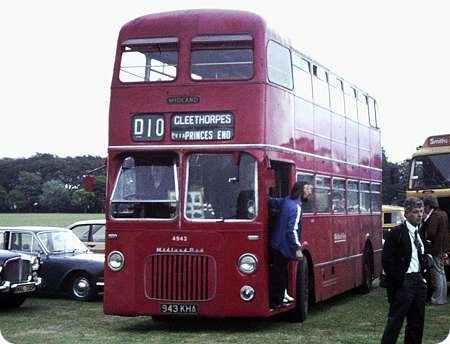
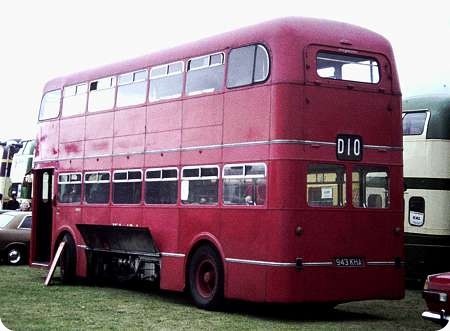
Midland Red (Birmingham & Midland Motor Omnibus Co)
1960
BMMO D10
BMMO H78F
This fascinating vehicle was the first of two prototype underfloor-engined double deckers built by Midland Red in 1960/61. AEC had shown such a layout was possible, with its Crossley-bodied Regent IV underfloor-engined decker prototype of 1950, which conformed to minimum gangway headroom requirements, while remaining within vehicle maximum height limits. The AEC had a rear platform however, whereas the Midland Red D10 design took this one step further in having the entrance alongside the driver. As was expected of Midland Red, advanced features were to the fore and the D10 sported chassisless construction, power steering, semi-automatic transmission, disc brakes and ‘Metalastik’ rubber suspension. However, the most interesting feature was the offsetting of the midships-mounted BMMO 10.5 litre horizontal Diesel engine to the nearside of the vehicle. In order to avoid raising the lower deck floor level more than necessary, the highest parts of the engine, the flywheel and housing, were thus positioned to the side of the gangway (under nearside seats) rather than being directly below it. Consequently the slimmer parts of the engine, the cylinder heads, were beneath the gangway, allowing it to be lower. A second prototype was built in 1961 (4944: 1944 HA), and was originally to a two door / two staircase layout. The front entrance was of normal width but the rear exit was of a narrow design, and 4944 was converted to conventional single door/single staircase layout in 1962. (Intriguing how the HA registration followed the KHA mark, rather than the other way around). No more D10’s were built, but fortunately 4943 has been preserved, and is seen here in Harrogate at a Trans-Pennine Rally in, I think, the mid-70’s.
Photograph and Copy contributed by Brendan Smith
24/10/13 – 08:06
The D10s always appear to me to look quite tall . . . what was the overall height? and how does that compare with a Volvo Citybus or Leyland Lion DD?? Presumably, if BMMO had put the D10 into production “new bus grant” would have subsequently killed-off the under-floor design anyway (even if BMMO hadn’t been forced to cease vehicle production in 1971[?]). But here’s a thought: couldn’t the off-set engine layout have formed the basis for a lower-floor under-floor-engined single-decker – more suited to urban use then contemporary designs, and perhaps an alternative to rear-engined chassis?
Philip Rushworth
24/10/13 – 08:07
The D9 was sometimes called the Birmingham Routemaster, so this could be the Birmingham FRM. No one really mentions that the Q was a design not unlike this – but way before its time. Of course the Volvo D10M or B10DM (depending on age and in which factory it was built) was perhaps the most successful bus of this concept – but don’t forget the Leyland Lion either. Good that 943 is still with us, though.
David Oldfield
24/10/13 – 08:08
And, about 25 – 30 years later, came the Volvo D10M, as used by Southdown. Once again, Midland Red leads the field! Nice views, Brendan. Thanks for posting!
Pete Davies
24/10/13 – 09:29
Do I spy a Wulfrunian lurking in the background of the second shot.
David Oldfield
25/10/13 – 07:54
I think you did, David. Allowing for perspective look at the heights?
Joe
25/10/13 – 07:55
Have you noticed that every window bay in the lower deck and every bay except the front in the upper deck has a sliding window included (ok hinged vent in rear upper deck bay). That’s quite unusual. I worked in Stoke when the two D10s were at nearby Stafford yet I never went to look for or travel on them. Can’t believe it!
Ian Wild
25/10/13 – 12:49
Sometimes we could kick ourselves for missed opportunities, Ian.
David Oldfield
26/10/13 – 07:29
As far as I know all BMMO double deckers built from 1950 onwards, D5s through to D10s, had a full set of sliding vents both sides, with the exception of the all Leyland LD8s.
Tony Gallimore
30/10/13 – 11:52
Both of the D10’s ended their days operating from Stafford depot. One day my friend and I caught the train from Manchester to Stafford to spend the day riding on Midland Red buses; we visited Walsall and Wolverhampton. On returning to Stafford we had half an hour to wait for the train, and one of the D10’s was in service. We boarded it and travelled to the first stop, just to say we had ridden on a D10!
If the D10 had entered production, would it have been copied by other bus builders? It might have resulted in a shorter production life for the Atlantean and Fleetline.
Don McKeown
07/11/13 – 08:00
Not sure if I have put this in the correct posting.
May I add some comments on the BMMO underfloor engine? As a Midland Red engineering supervisor at a certain garage operating CM6’s and numerous other types, for many years, there are one or two points that should be mentioned. One is that having worked on these and Leyland Leopards side by side, the huge difference in engine accessibility cannot be ignored. The BMMO engine was surrounded by acres of empty space, every necessary component was easily accessed, often from under the side without need for a pit. The starter motor for example, could be changed in five minutes flat. I know, I did it many times. Alternator, water pump, fuel system etc, ditto. Jobs that would take at least twice as long on a Leopard. And this brings me to point number two: the cooling system. The BMMO system was non-pressurised, it ran cool most of the time, largely due to the large water capacity – I think 17 gal. on S17/CM6 onwards-no cooling fan, and those masses of empty space to allow air in! And a cylinder head design which would tolerate a leaky gasket for days if kept topped up, despite a radiator of oily water.., at least, in local use. A blown head gasket on a Leopard spelled trouble! Usually a cracked cylinder liner unless you were lucky. It was a great shame that the magnificent BMMO 10.44 litre engine wasn’t adopted for a new standard NBC design: I believe a top secret rear engined prototype was built and tested at the beginning of the 1970s, but the Leyland lobby won the day, and we got the dreaded National… thanks for the chance to talk of old times…great times.
Michael F
07/11/13 – 09:35
Another sad indictment of NBC and BLMC Michael.
David Oldfield
12/06/14 – 08:24
“Intriguing how the HA registration followed the KHA mark, rather than the other way around.”
Smethwick started reversed registrations in September 1955 with 1 AHA. Upon reaching 999 MHA in April 1960, they decided to start issuing 501 HA etc on cars, buses and trucks – the three-letter series continuing only on motorcycles.
They reached 9719 HA before adopting the year suffix system in August 1964.
Des Elmes
12/06/14 – 10:09
Fascinating to read Michael F’s account of the D10’s qualities and of its unfulfilled potential, and until reading Brendan’s piece I hadn’t appreciated how ingeniously the designers had positioned the engine to minimise intrusion. One question: surely such a concentration of weight on the nearside—not only the engine but the gearbox as well—must have caused problems? At least the AEC Q had an offside engine, tending to counteract the road-camber effect.
Ian T
12/06/14 – 14:15
I assume that Cleethorpes did not normally figure on Midland Red destination blinds – not double deckers at any rate?!
Stephen Ford
12/06/14 – 17:29
Ian, the location of the fuel tank on the offside would have surely contributed some weight balance to a degree. Thinking of unbalanced chassis, I wonder if the Bristol VRL might have suffered from handling problems with the concentration of so much weight in the overhung offside rear corner.
Roger Cox
17/06/14 – 06:55
Ian, Peter Nash’s fascinating book ‘Push Once – life in the bus industry’ mentions problems related to the D10’s engine being mounted off centre. Apparently this did cause brake linings and parts of the suspension system to wear unevenly, but the most serious problem appears to have been that “the engine location compromised the integrity of the frame leading to cracks in stress panels in later life”. As the vehicles were in effect prototypes, surely this problem could have been overcome with further development? That said, Bristol-ECW encountered a few structural problems over the years with the LS semi-integral design, and eventually the model was replaced by the MW, which reverted to a traditional chassis frame.
Brendan Smith
25/06/14 – 08:27
There must have been some issues with cooling as at some point 4943 had been fitted with an electric fan, presumably thermostatically controlled. I dare say for the majority of time it was not needed, but I expect sitting in traffic queues may have made a difference, not that there were many of those in Stafford.
Mark
25/06/14 – 11:12
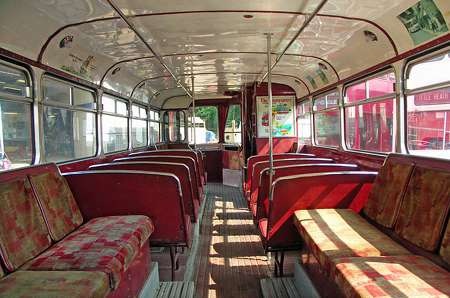

I took these pictures of D10 4943 in 2008. It can be seen the nearside seating was on a shallow platform, with the only real intrusion into the saloon of the mechanicals, in the form of a small ‘hump’ midway down.
Otherwise the floor area was remarkably clutter free.
Mark
25/06/14 – 13:11
Thx, Mark, for the photos. The floor is commendably level and clutter-free, with a complete lack of a dwarf-only area at rear of so many current buses! Mention of Stafford brings back memories of English Electric and 16MU RAF Stafford, where I was based until 1959, thus missing seeing this vehicle! I do recall the sole, grossly-overloaded bus which ran all night on Sunday nights, ferrying returning airmen to camp. Like the King Alfred Regent V healing over, displayed recently, we often wondered if our bus was going to recover from its alarming angle! Standing passengers upstairs does NOT aid stability!
Chris Hebbron
25/06/14 – 13:11
Regarding Cleethorpes on the blind, many Midland Red garages ran summer dated Holiday services to resorts, for example the Eastern/Leicester area garages ran to such places as Skegness, Mablethorpe, etc; these services more often than not were run by Dual Purpose vehicles : the point being the destination blind would be the same one fitted to every type of vehicle (except full coaches which rarely ran on any type of stage carriage). There were also other far flung places on some garages blinds, as again the stock with comfier seating would quite often be used on Associated Motorways work where BMMO would be joint operator of a route, and such places as Bristol, Cheltenham, Glasgow, Manchester etc. would feature.
Mark
25/06/14 – 18:09
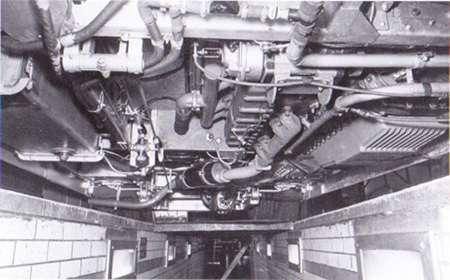
An interesting view of the underside of 4943, showing the deft positioning of the mechanicals. The engine was placed the opposite way round to the single-deckers i.e. cylinder heads towards the centre/crankcase to nearside, thus avoiding raising the floor level. Taken when new in Carlyle works – so ahead of it’s time.
Nigel Edwards
25/06/14 – 18:09
I remember seeing 16MU on the destination blinds of Stafford buses in the 80’s and wondering what it was, now I know!
Mark
23/06/15 – 06:39
The bearded gentleman leaning out of the bus is Keith Bodley, and I was probably not far away when this picture was taken.
Tony Martin
16/10/15 – 05:58
Having driven both D10s at Stafford “1965” I never found any handling problems, however one problem that did occur was with brake failure 4943 this was corrected though very quickly. One interesting point was D7 4162 was fitted with a turbo charger one could always tell the difference as with the engine under power it would have a whistling from the exhaust. Leyland Fleetline deckers were very unstable in windy conditions you were always correcting the direction of travel, also the single decker “Leyland National” would often not go over the slightly raised surface of bus stop laybys when it was raining no problem with any BMMOs though.Having travelled on many service buses throughout the last sixty years I have never found any modern PCV,s that matched the comfort quietness and lack of rattles of BMMOs.
Graham M
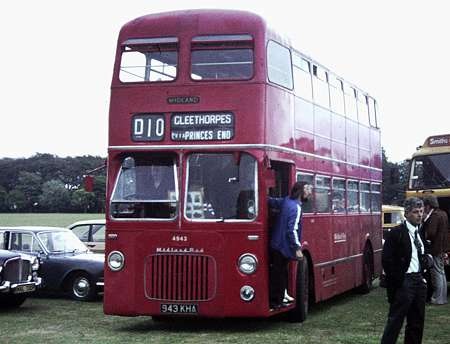 Vehicle reminder shot for this posting
Vehicle reminder shot for this posting
29/04/21 – 06:10
I have always been intrigued by the D10s. Mr Sinclair seemed obsessed with horizontal engines but I really feel that the design that might have worked better would be the vertical offside side engine, under a longitudinal seat near the offside front wheel as per the AEC Q. The balance of the chassis would have been better and accessibility would have been easier. Plus, a proper rear overhang, rather than that of the Q, dictated by absurd length restrictions, would have improved traction as compared to the Q. With hindsight, the front entrance maximum capacity double decker was the way forward, and a lower saloon totally given over to seating would have been ideal.
Ian Docherty
29/04/21 – 10:06
The Q was angled rather than vertical and Sinclair and his mentor O C Power developed the AEC SE4 & SE6 (I think) for Northern in the 30s both following the side angled concept. Neither were successful mainly to the need for a higher floor and convoluted drive line to the drive axle. I think the D10 was a typical BMMO move to test the envelope like so many of their previous designs.
Roger Burdett
30/04/21 – 07:02
The AEC Q had an almost straight drive line to the differential on the rear axle which carried only single tyres. Even so, convoluted drive lines did not prevent the first generation of rear transverse engined buses becoming commercial successes. I have often thought that a re-engineered Wulfrunian with the engine located behind the offside front wheel might have been practicable, but Guy ran out of money for Wulfrunian development.
Roger Cox
01/05/21 – 05:41
Am I right though that the prop came out the gearbox at an angle? From my memory of working on a Q, I do not remember a diff hump in the saloon ie high floor. Was the gearbox mounted at the front or the rear of the engine? ie rodding or cable?
Roger Burdett
02/05/21 – 06:08
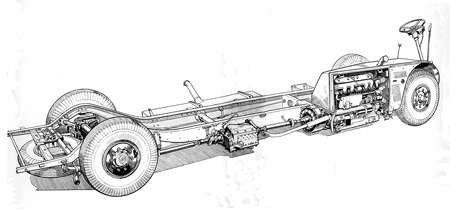
Here is a drawing of the Q type chassis design. It cannot be seen here , but the differential was set close to the offside rear wheel.
Roger Cox
03/05/21 – 07:03
Thanks for the drawing Roger (C). The single rear tyres would no doubt help in keeping the driveline as straight as possible, as it would allow the diff to be further over to the offside. It’s not something I’d even thought about until seeing your posting. It would also explain why Roger (B) couldn’t remember seeing a diff hump in the floor line.
Brendan Smith
03/05/21 – 07:03
I think the offset differential was one of the main reasons for the Q having single rear tyres.
Was the diff actually mounted on the outside of the chassis frame?
Eric Bawden
03/05/21 – 07:04
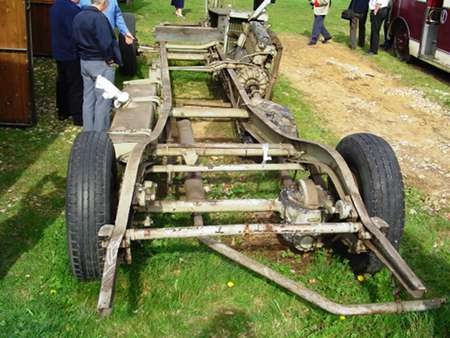
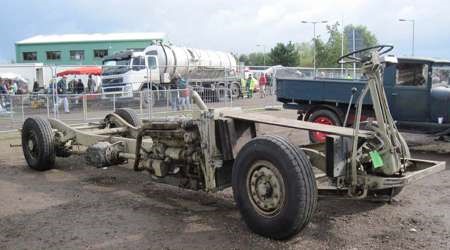
Are these of any use?
Tony Fox
Leave a Reply